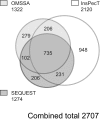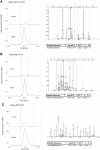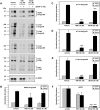Phosphoproteomic profiling reveals vasopressin-regulated phosphorylation sites in collecting duct
- PMID: 20075062
- PMCID: PMC2834543
- DOI: 10.1681/ASN.2009070728
Phosphoproteomic profiling reveals vasopressin-regulated phosphorylation sites in collecting duct
Abstract
Protein phosphorylation is an important component of vasopressin signaling in the renal collecting duct, but the database of known phosphoproteins is incomplete. We used tandem mass spectrometry to identify vasopressin-regulated phosphorylation events in isolated rat inner medullary collecting duct (IMCD) suspensions. Using multiple search algorithms to identify the phosphopeptides from spectral data, we expanded the size of the existing collecting duct phosphoproteome database from 367 to 1187 entries. Label-free quantification in vasopressin- and vehicle-treated samples detected a significant change in the phosphorylation of 29 of 530 quantified phosphopeptides. The targets include important structural, regulatory, and transporter proteins. The vasopressin-regulated sites included two known sites (Ser-486 and Ser-499) present in the urea channel UT-A1 and one previously unknown site (Ser-84) on vasopressin-sensitive urea channels UT-A1 and UT-A3. In vitro assays using synthetic peptides showed that purified protein kinase A (PKA) could phosphorylate all three sites, and immunoblotting confirmed the PKA dependence of Ser-84 and Ser-486 phosphorylation. These results expand the known list of collecting duct phosphoproteins and highlight the utility of targeted phosphoproteomic approaches.
Figures










Similar articles
-
Vasopressin regulation of multisite phosphorylation of UT-A1 in the inner medullary collecting duct.Am J Physiol Renal Physiol. 2015 Jan 1;308(1):F49-55. doi: 10.1152/ajprenal.00642.2013. Epub 2014 Nov 5. Am J Physiol Renal Physiol. 2015. PMID: 25377918 Free PMC article.
-
Vasopressin increases phosphorylation of Ser84 and Ser486 in Slc14a2 collecting duct urea transporters.Am J Physiol Renal Physiol. 2010 Sep;299(3):F559-67. doi: 10.1152/ajprenal.00617.2009. Epub 2010 Jun 24. Am J Physiol Renal Physiol. 2010. PMID: 20576681 Free PMC article.
-
Phosphoproteomic identification of vasopressin V2 receptor-dependent signaling in the renal collecting duct.Am J Physiol Renal Physiol. 2019 Oct 1;317(4):F789-F804. doi: 10.1152/ajprenal.00281.2019. Epub 2019 Jul 17. Am J Physiol Renal Physiol. 2019. PMID: 31313956 Free PMC article.
-
Phosphoproteomics of vasopressin signaling in the kidney.Expert Rev Proteomics. 2011 Apr;8(2):157-63. doi: 10.1586/epr.11.14. Expert Rev Proteomics. 2011. PMID: 21501009 Free PMC article. Review.
-
Biochemical Modification and Subcellular Trafficking of Urea Transporters.Subcell Biochem. 2025;118:63-85. doi: 10.1007/978-981-96-6898-4_4. Subcell Biochem. 2025. PMID: 40637977 Review.
Cited by
-
Bayesian analysis of dynamic phosphoproteomic data identifies protein kinases mediating GPCR responses.Cell Commun Signal. 2022 Jun 3;20(1):80. doi: 10.1186/s12964-022-00892-6. Cell Commun Signal. 2022. PMID: 35659261 Free PMC article.
-
Proteomic profiling of nuclear fractions from native renal inner medullary collecting duct cells.Physiol Genomics. 2016 Feb;48(2):154-66. doi: 10.1152/physiolgenomics.00090.2015. Epub 2015 Oct 27. Physiol Genomics. 2016. PMID: 26508704 Free PMC article.
-
Phosphoproteomic response to epidermal growth factor in native rat inner medullary collecting duct.Am J Physiol Renal Physiol. 2025 Jan 1;328(1):F29-F47. doi: 10.1152/ajprenal.00182.2024. Epub 2024 Nov 7. Am J Physiol Renal Physiol. 2025. PMID: 39508840
-
Minireview: progress and challenges in proteomics data management, sharing, and integration.Mol Endocrinol. 2012 Oct;26(10):1660-74. doi: 10.1210/me.2012-1180. Epub 2012 Aug 17. Mol Endocrinol. 2012. PMID: 22902541 Free PMC article. Review.
-
BIG: a large-scale data integration tool for renal physiology.Am J Physiol Renal Physiol. 2016 Oct 1;311(4):F787-F792. doi: 10.1152/ajprenal.00249.2016. Epub 2016 Jun 8. Am J Physiol Renal Physiol. 2016. PMID: 27279488 Free PMC article.
References
-
- Nielsen S, Frokiaer J, Marples D, Kwon TH, Agre P, Knepper MA: Aquaporins in the kidney: From molecules to medicine. Physiol Rev 82: 205–244, 2002 - PubMed
-
- Brown D: The ins and outs of aquaporin-2 trafficking. Am J Physiol Renal Physiol 284: F893–F901, 2003 - PubMed
-
- Yano Y, Rodrigues AC, Jr., de Braganca AC, Andrade LC, Magaldi AJ: PKC stimulated by glucagon decreases UT-A1 urea transporter expression in rat IMCD. Pflugers Arch 456: 1229–1237, 2008 - PubMed
-
- O'Connor PM, Cowley AW, Jr.: Vasopressin-induced nitric oxide production in rat inner medullary collecting duct is dependent on V2 receptor activation of the phosphoinositide pathway. Am J Physiol Renal Physiol 293: F526–F532, 2007 - PubMed
Publication types
MeSH terms
Substances
Grants and funding
LinkOut - more resources
Full Text Sources

